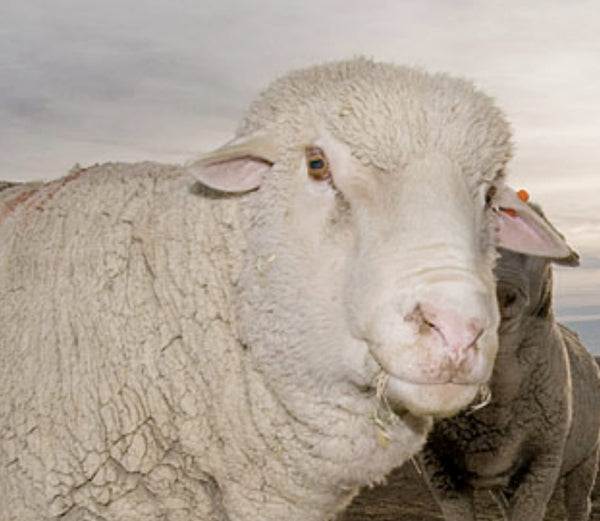Know Your Fiber: Targhee Wool
Posted on July 01 2018

Targhee sheep, one of the youngest breeds of sheep in North America, have been experiencing a surge of interest from spinners and hand-dyers in the last several years. This American sheep breed has wool that can be as soft as some Merino wools. However, while most of the Merino in the world comes from Australia and China, the majority of Targhee wool comes from farms right here in North America. To tell the story of Targhee sheep, though, we should start with the saga of sheep and the American West.
Settlers began to push west around the mid-1700s, but it wasn’t until the early 1800s that they first began to establish permanent settlements in what we think of today as the American West. As these settlers began to establish permanent settlements, they brought their livestock with them, including sheep. By the mid-1800s, the first sheep and cattle had arrived in these territories.
The first European-Americans to venture into the territories we today know as Montana, Wyoming and Idaho were mainly missionaries, although the primarily European-American settlers who would later create the farms and ranches in those areas followed shortly after. Settlers to those lands saw an ideal place to raise their cattle and sheep – the relatively dry climate and wide, open expanses of grasslands provided ideal grazing for these animals. Indeed, the native Bighorn sheep had been already made their home in these regions for millennia before European sheep started to arrive. The people who lived in those parts of North America before U.S. settlers ever discovered it had already been making use of these native sheep for ages. Although Bighorn sheep were never domesticated as European sheep were, people living in that part of North America managed the landscape through regular burnings done to improve the habitat for Bighorn sheep and other animals that were hunted for food. In addition to providing food, the Bighorn sheep also provided the wool that was used by the people of that area in their weavings.
The arrival of settlers and their claims to the lands of the American West did not go unchallenged by the people of the many tribes who already lived there. The battles between the U.S. and the tribes, raids on the settlers and other similar responses have been well documented in history books. The battles to remain on their lands and keep U.S. settlers from taking their lands would not be successful, though. By the mid-1800s, tribal reservations created by the U.S. government were already starting to be formed, and with that, the expansion of farms and ranches throughout the West began in earnest.
As more and more settlers arrived, the land available for grazing cattle and sheep began to get fenced off. There was gradually less and less land freely available for open grazing as more and more settlers arrived. Ranchers who raised cattle wanted fenced ranges; ranchers who raised sheep needed open ranges. Cattle ranchers accused the sheep of contaminating their cattle with sheep scab; sheep ranchers denied it. Soon, fences were cut, feuds over grazing land broke out, and the Sheep and Cattle Wars of the West began around the 1870s. This resulted in murders of people and killing of livestock. Largely, the livestock that was killed were sheep – in retaliation for fence cutting or grazing on land they considered to be theirs, cattlemen would kill sheep by shooting or even driving them off cliffs.
The Sheep and Cattle Wars started tapering off by the 1890s. The cattle industry had started to decline in Montana, Wyoming and the surrounding regions, in part due to a particularly harsh winter during 1886-1887. Although there were still isolated sheep/cattle feuds in the region through the early 1900s, sheep began to significantly outnumber cattle as more and more ranchers discovered the durability of sheep and their ability to survive on forage that cattle would not eat.
The USDA had been established by President Lincoln in 1862. Among other things, one of its mandates was to work with farmers to introduce and create new breeds of plants and animals that could increase agricultural production. Up to the 1900s, sheep had not been of any major interest to this department, however, this was about to change. Through the early 1900s, many of the sheep raised in the West were some combination of purebred and crossbred Merinos and Rambouillets, bred for their wool. However, with the early 1900s came an increased demand for lamb meat, and this caught the attention of the USDA. What if they could help breed a sheep to produce not only quantities of both soft wool and meat, but that was also optimized for the western part of the U.S. where most sheep were raised?
Although the USDA had previously dabbled in working with sheep ranchers to develop sheep particularly suitable to the western regions, in 1915 they decided to go all in with the creation of the U.S. Sheep Experiment Station in Dubois, ID. The Sheep Experiment Station’s first project was to create the Columbia, a mix of Rambouillet and Lincoln sheep. It was a popular sheep but didn’t quite have the wool qualities that sheep ranchers were looking for.
In 1926, researchers at the U.S. Sheep Experiment Station began laying the groundwork to develop a breed of sheep that would better meet the requirements of sheep ranchers of the region. They brought in outside Rambouillet, Lincoln, and Corriedale sheep to breed with nine Rambouillet rams already kept by the station, and by 1938 the Targhee sheep was born.
Named after the national forest where the sheep grazed during the summer (which in turn is said to be named after a leader of the Bannock tribe), Targhee sheep began to be raised by ranchers, and increased in popularity so that by the late 1940s many ranchers were breeding their Targhee-type sheep with actual Targhee sheep to further improve the breed. The first official registration of Targhees happened in 1952 with the registration of 34 Targhees from Montana State University. By then, Targhees had become an extremely popular breed of sheep for ranchers in Idaho, Wyoming, Montana, the Dakotas, and the surround regions. Over the decades the Targhee’s popularity has only increased, and it is not difficult to find ranchers successfully raising Targhee sheep throughout both the Western and the Midwestern regions of the U.S.
At a width of 21-25 microns, Targhee is classified as a fine wool. It is a resilient, elastic wool with a softness that can rival Merino. Spinners find Targhee drafts similarly to Merino and love it for its softness. Dyers love Targhee for its ability to take color well and its matte finish. Are your looking to try out some Targhee for your next spinning project? We have sliver ready and waiting just for you! Check out our Targhee sliver, as well as our other fibers and yarns in our store or online. We look forward to seeing what you create!

Follow US